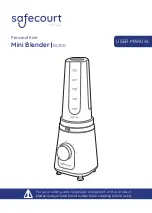
77
6. Clean the lid and the inner lid with warm soapy water.
7. Rinse the blender jug, lid, and inner lid with clear water and dry the parts tho-
roughly and carefully with a cloth or leave all parts dry naturally where they are
out of reach of young children.
Note
The blender jug, lid, inner lid, blade assembly housing and silicon seal are dish-
washer safe. The lid, inner lid, blade assembly housing may be washed in the
dishwasher in the top shelf only on a standard wash. The blender jug may be
placed in the bottom shelf. Max. 60°C.
WARNING:
Pay attention not to cut yourself cleaning around the blade or
cleaning the blade.
Important:
The blender jug should be clean now. For the case that there are stub-
born residues on the blender jug or the blade, disassemble the blender jug and
clean the single part (see ›Assembling and disassembling the appliance‹). Soak
the parts in warm soapy water.
DISASSEMBLING THE BLENDER JUG AND REMOVING STUBBORN
RESIDUES
WARNING:
The blade is very sharp! Do not touch the blade. To handle the
blade, always hold on to the blade assembly housing.
1. Remove the blender jug off the motor block and hold it over the sink or a lar-
ge bowl. Turn the blender jug upside-down. The underside of the knife unit is
now up. Grasp with the left hand the handle of the blender jug and with the
right hand the plastic holder of the knife unit. Remove the knife unit by turning it
counter-clockwise. Take the knife unit off the blender jug.
ATTENTION:
The blender jug might be connected really tight to the holder.
Do not use force unscrewing it.
2. Rinse all parts in warm soapy water. Soak stubborn residues for a few minutes
and then remove them using a nylon washing brush or sponge. Do not cut your-
self. Beware not to damage the silicone seal. If you can not get the sealing ring
clean or if it is porous or damaged you have to replace it. Contact your vendor
for replacement parts.
















































